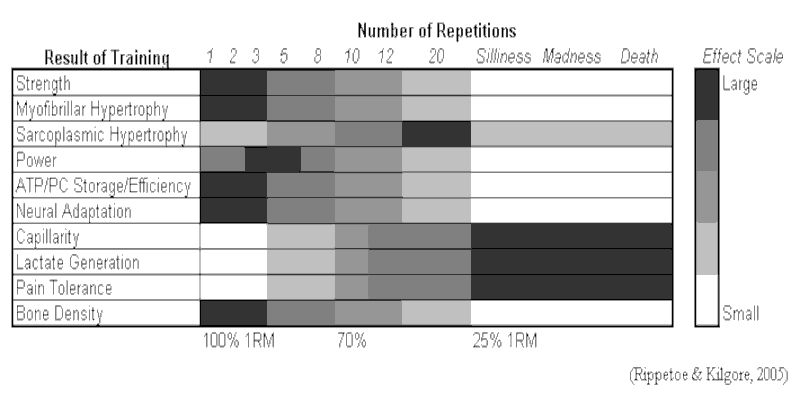Table of Contents
ToggleThere are a lot of subtle differences in the weightlifting world regarding rep ranges, how many sets to perform, and how long the rest time between sets should be.
A lot of this depends on whether your main goal is increasing strength, gaining muscle mass, or getting leaner.
These are the best rep ranges for weightlifting and endurance according to science.
The different rep ranges explained

A rep (also called repetition) range, is a fixed scope of repetitions that are performed when exercising or lifting weights. In other words, it’s how many times you perform one particular exercise without resting in between the reps.
Let’s take squatting as an example. Each time you lower the barbell by bending your knees and returning to the starting position by extending your knees and hips counts as one repetition. If you did this 10 times without resting in between the reps, then you would’ve performed 1 set of 10 reps.
There is no single best rep range. The rep range that is most suited to your needs depends on what your goal is. If your goal is strength, then you’re best off lifting in the lower rep ranges. Between 1–5 reps on average.
If your main goal is increasing muscle mass, then your best bet is lifting in a moderate rep range. Between 8–12 reps on average. If you’re training for muscular endurance, then you would ideally be looking to perform a higher amount of reps. Preferably above 12 reps.
Still, there is some carryover between strength, endurance, and training for mass.
What is a set in weightlifting?
A set, in weightlifting terms at least, is the collection of a predetermined amount of reps of one particular exercise we perform without rest.
For example, if we do squats for 10 reps, take a rest, and do squats again for 10 reps, then we do 2 sets of squats for 10 repetitions. In this case, we predetermined that one set of squats would be 10 reps.
What is rest time?

Rest time means, you guessed it, how long the period of rest is between sets.
How long the break between sets should be, depends on the training intensity (high vs. low loads) and whether the goal of the training is strength, muscle mass, or improved endurance.
In general, the ideal rest time for strength training is longer, between 3–5 minutes, while for training for muscle mass, the average rest time is shorter, between 1–3 minutes. When training for muscular endurance, breaks are kept very short since the load is much lighter.
So how long you need to rest depends on:
- The goal of your training
- Heavy or light loads when training
- High or low training volume
- How well-trained and conditioned you are
How many rep ranges are there?
There are mainly 3 rep ranges being used in weightlifting. In reality, there are a lot more rep ranges than just those 3.

The rep ranges you ideally use depends on your goal. The best rep ranges will vary depending on whether your goal is increasing strength, muscle building (hypertrophy), or building muscular endurance.
Although there is a bit of overlap between these 3 rep ranges. What I mean with this statement is that the rep range of 5 repetitions for instance will mostly build muscular strength. But it will also build a fair bit of muscle mass. That is if you eat enough calories and protein.
You can’t train strictly for strength, muscle mass, or muscular endurance. Other areas and muscle fibers for which you don’t specifically train will improve a bit as well.
There is no “fixed” single best rep range that suits every individual since everyone’s body responds a bit differently to stimulus (in this case, the stimulus is lifting weights).
For example, 5 reps might work best for me to induce strength gains while for you, it might be 3 reps. While both rep ranges are different, I’d like to note that both these scopes are still in the advised amount of repetitions for strength-based workouts.
So knowing your body and experimenting with the different rep ranges is advised for the best results for each individual.
However, the following rep ranges can be used as a solid general guideline.

Strength training is performed by lifting heavy loads for a low amount of reps
Research shows that lifting high loads for a low amount of reps will induce the most strength gains.
The best rep range for strength is generally between 1–5 reps. People who train primarily for strength are called powerlifters in the weightlifting community.
Mass (hypertrophy) training is performed by lifting moderate loads for a moderate amount of reps
Research shows that a higher amount of volume with moderate weight is best for increasing muscle mass.
The hypertrophy rep range is typically 8–12 reps and is mainly where the most gains in muscle mass occur. Although there’s a bit of discussion, rep ranges might vary slightly depending on the article and the training subjects.
Time under tension is also very important for gaining muscle mass. The longer the muscle stays under tension (lifting slower) the more muscle mass is gained. So the eccentric part of a weightlifting exercise should be performed slowly.
Endurance training is performed by lifting light loads for a high amount of reps
Largely, 12 reps and more is considered endurance-based training. But again, this might vary on the articles or research papers that are advised.
Yet, most papers conclude that low loads for a high amount of reps are best to increase muscular endurance.
The muscle fibers in these higher reps ranges become more resistant to fatigue, meaning they can last longer without getting tired.
Best rep range to build muscle

Generally, the best rep range for muscle growth is between 8–12 repetitions. Although the best hypertrophy rep range is between eight and twelve repetitions, some grow better with lower, and some with a higher amount of reps than this general guideline.
However, it’s important to note that time under tension and eating well are important too concerning building muscle size.
Best rep range for power
The best rep range for power is generally between 1–5 repetitions. And although the best rep range for strength is mainly low, some will get stronger at a faster rate with a very low amount of reps, and some with a little more.
A low amount of repetitions with heavy weight is thought of as optimal to build strength.
Best rep range for muscular endurance

The best rep range for muscular endurance is around 12 reps and up.
The more reps are executed without resting, the more muscular endurance comes into play.
A high amount of repetitions with a light weight is considered optimal to build muscular endurance.
Combining rep ranges in a training program
It is possible to vary rep ranges in one workout. It’s also doable to switch rep ranges every workout or every so often.
For example, your main focus can be gaining strength (between 1–5 reps) and your assistance work during that workout can be hypertrophy/muscle-building based. (8-12 reps.)
This way, you can get stronger, and gain muscle mass at the same time. However when you start combining different rep ranges you will need to sacrifice a bit of strength, muscle mass, or muscle endurance because your training becomes less specifically focused on one area, so keep that in mind. Unfortunately, we can’t have it all.
It’s also possible to choose one rep range if your goal is for example both strength and muscle mass gains. Between 5–8 reps will in this case get you a bit of both because there is overlap between both rep ranges.
But again, if you would go for maximal strength output, your ideal rep range would be 5 reps and lower while if you would be training for size, your ideal rep range would be between 8–12 reps.
How many reps and sets should you perform?

Again, how many reps and sets you should perform mainly depends on 3 things.
These 3 things are training intensity (high vs low load), the training volume (how many reps and sets), and the training frequency.
Training intensity
Training intensity refers to the percentage of your 1 rep max you are lifting (high vs low load)
High-intensity workouts generally involve a low amount of reps for a low amount of sets. Low-intensity workouts involve a high amount of reps and a high amount of sets.
Training volume
Training volume pertains to the amount of reps and sets being performed during one particular workout
High-volume workouts mostly involve a moderate to high amount of reps and a high amount of sets. Low-volume workouts involve a low amount of reps and a low amount of sets.
Training frequency
The training frequency relates to how many times you train one particular muscle group each week
A high-frequency training program usually features a lower amount of reps and sets to balance out the high training frequency. A low-frequency training program is the opposite.
The optimal rest time in between sets

How much time you need to rest in between sets depends on the loads you are lifting (heavy vs light weights), the training volume, the goal of your training (strength, mass, …), and how conditioned you are.
We must realize that there’s not 1 best rest time between sets.
The main purpose of rest time is implied in the name itself. The goal is to allow your muscles ample time to recover to get them ready to engage in physical activity again.
The rest time in between sets listed below can be used as a solid general guideline. Keep in mind though that these can vary slightly in different research papers.
2–4 minutes of rest for strength training
2–4 minutes of rest is generally recommended between sets when doing strength training
This way, your muscles have ample time to recover to lift a heavy load again.
1–2 minutes of rest for hypertrophy/mass training
1–2 minutes of rest is recommended between sets when training for hypertrophy/muscle mass
When training for hypertrophy, rest times can be kept lower than when you’re performing strength training because the loads being lifted are lighter. This allows us to recover at a faster rate.
30 seconds-1 minute of rest when performing anaerobic-based endurance training or muscular endurance training.
About 30 seconds-1 minute of rest is recommended when performing anaerobic-based endurance training or muscular endurance training
When working out in this manner, our heart rate stays relatively high, which is the foundation of anaerobic training.
The rest time when performing super sets

A superset involves performing two or more consecutive sets of different strength work with little or no rest between sets.
In other words, the break is kept as short as possible.
The best rest time for muscle growth
The best rest time for muscle growth is generally between 1–2 minutes of rest.
In reality, though, the duration of our rest time will be greatly dependent on the loads we are lifting. (Heavy vs light loads.)
Best rest time for strength
Generally, the best rest time for strength is between 2–4 minutes of rest.
This will give your body time to recover for the next heavy set. Beware though that even longer rest periods can and will be needed when lifting very heavy loads.
Best rest time for endurance

Generally speaking, the best rest time for muscular endurance is between 30 seconds to 1 minute of rest.
My personal take

The best amount of reps, sets, and rest time is not an exact science that’s set (no pun intended) in stone and probably never will be as each individual is slightly different.
However, we know that the best rep range for muscle growth will not be the best rep range for building mass.
But, the above principles should provide you with a general guideline that is geared towards your specific training goal(s). This will in turn yield better results and allow you to reach your goals at a faster rate.
But like I said before, every person is unique and responds to stimuli a bit differently from other people. So don’t be afraid to switch things up slightly to discover what works best for you.
1 thought on “The best rep ranges, sets, and rest time for weightlifting explained”
Comments are closed.